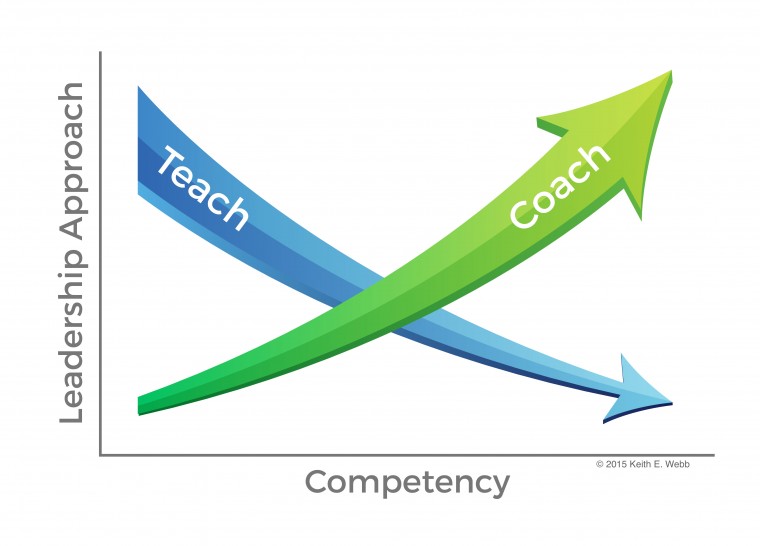Reading: How To Choose When To Teach and When To Coach
How To Choose When To Teach and When To Coach
When leading others, your leadership approach will influence how successfully others will perform their jobs. It’s important to know when to teach and when to coach. Get it wrong and you can do more damage than good. Get it right and you can motivate and empower people for excellent results.

Teaching and coaching are not the same things. Each is a leadership approach that can achieve good results in the appropriate situation. Let’s look at each skill, then I’ll share my experience training our new Administrator.
When To Teach
The first question to ask yourself is: Is the person capable in this task? Capable, doesn’t mean perfect. And it doesn’t mean they do the task the way you would do it. Have they been instructed in how to do it? Have they done it before?
If the answer to these questions is “yes,” then don’t teach them.
If you teach a task-capable person that same task you’ll appear arrogant, directive, and out of touch. They will believe you are either not seeing their performance or that you don’t think they are capable, which they feel they are. It demotivates and reduces trust. If they need further instruction to do the task differently, try coaching them instead.
If the person hasn’t done the task before, then teach them the task.
There are many ways to teach, and only one is to lecture them. Depending on the task, you can teach by demonstrating, giving a list of the task’s process steps to read and follow, asking another person to teach them, and of course, you telling them the procedure.
Coaching is about drawing out information and skill from the other person. If they’ve been taught how to do a task, then there is information – the previous instruction, their experience trying the task, etc. – to draw on. Don’t jump back into teaching mode. Ask questions instead.
For example:
- What part is unclear?
- What are you doing that is working? Not working?
- What have you tried so far?
Asking these questions shows respect for the other person. It says, I think you’re a capable person even though you’re still learning this task. It also enables you to pin-point where the difficulty lies. Missing information? Missing skill? The problem is often not where we think it is.
What I Learned Training Our New Administrator
Here’s an example of how I chose when to teach and when to coach. Earlier this year, I hired a person to takeover much of the adminstration for my business. Because we use special software she didn’t know how to do the tasks involved. I had to teach each task and then support her in becoming competent to do them.
Here’s what I learned:
- It’s faster for me to just do the task than to teach it. It’s short-sighted, I know. But I had to keep reminding myself, “If you take the time up front to teach her, you won’t have to take much time on this task in the future.” Many leaders in solo and small organizations never get past this one.
- I had to become better organized. I wrote up Standard Operating Procedures (SOP) for each task. That took time. I had to decide exactly how the task was to be done in order to describe each step.
- I taught her by following the SOP and doing the task with her. This process revealed flaws in my SOP – missing steps that I intuitively knew, decisions she can’t be expected to make, and overall too much complication. I found myself irritated at this process (not her) because now I’m giving even more time to things I’m trying to get off my plate. Yet, if I didn’t work through this process she couldn’t be successful. And all the admin work would remain with me.
- She needed help but not to be re-taught. Some tasks she did perfectly, others she needed help on. Here’s where the choice between teaching and coaching comes in. My first inclination was to say, “Here, I’ll show you again.” Rarely did she need to be taught again from the beginning. It was usually a step in the middle somewhere that wasn’t clear. I identified the need by asking, “What specifically isn’t clear?”
- Questions helped us find solutions quickly. Using questions, I asked her to identify what wasn’t clear. Then asked questions to troubleshoot from there. Often it was a missing or unclear SOP step.
- Coaching allowed me to affirm progress. This is a biggie! As she clicked through the steps, I noticed her competence in doing tasks had increased. I saw much that I could affirm even while helping her with a small point. If I re-taught her, I would not have seen what she could do and wouldn’t have affirmed it.
All this was task-based. Meaning, we looked at her ability to do each task and then I responded with the appropriate leadership approach. Which means in practice, you will sometimes teach and sometimes coach the people you work with. We need to be ready to switch from one to the other as needed.
Good leaders give the time to help others learn what they need to know to be successful in their jobs.
